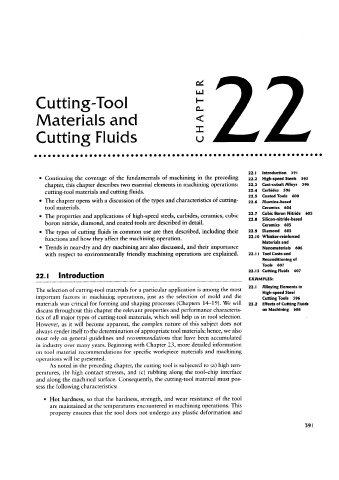Page 610 - 04. Subyek Engineering Materials - Manufacturing, Engineering and Technology SI 6th Edition - Serope Kalpakjian, Stephen Schmid (2009)
P. 610
Materials and
Cutting Fluids
22.l Introduction 59|
° Continuing the coverage of the fundamentals of machining in the preceding 22.2 High-speed Steels 595
chapter, this chapter describes two essential elements in machining operations: 22.3 Cast-cobalt Alloys 596
cutting-tool materials and cutting fluids. 22.4 Carbides 596
22.5 Coated Tools 600
° The chapter opens with a discussion of the types and characteristics of cutting- 22.6 Alumina-based
tool materials. Ceramics 604
° The properties and applications of high-speed steels, carbides, ceramics, cubic 22.1 Cubic Boron Nitride 605
22.8 Silicon-nitride-based
boron nitride, diamond, and coated tools are described in detail. Ceramics 605
0 The types of cutting fluids in common use are then described, including their 22.9 Diamond 605
functions and how they affect the machining operation. 22.10 Whisker-reinforced
Materials and
° Trends in near-dry and dry machining are also discussed, and their importance Nanomaterials 606
with respect to environmentally friendly machining operations are explained. 22.ll Tool Costs and
Reconditioning of
Tools 607
22.I2 Cutting Fluids 607
22.l Introduction
EXAMPLES:
The selection of cutting-tool materials for a particular application is among the most 22.I Alloying Elements in
High-speed Steel
important factors in machining operations, just as the selection of mold and die CuttingTools 596
materials was critical for forming and shaping processes (Chapters 14-19). We will 22.2 Effects of Cutting Fluids
discuss throughout this chapter the relevant properties and performance characteris- on Machining 608
tics of all major types of cutting-tool materials, which will help us in tool selection.
However, as it will become apparent, the complex nature of this subject does not
always render itself to the determination of appropriate tool materials; hence, we also
must rely on general guidelines and recommendations that have been accumulated
in industry over many years. Beginning with Chapter 23, more detailed information
on tool material recommendations for specific workpiece materials and machining
operations will be presented.
As noted in the preceding chapter, the cutting tool is subjected to (a) high tem-
peratures, (b) high contact stresses, and (c) rubbing along the tool-chip interface
and along the machined surface. Consequently, the cutting-tool material must pos-
sess the following characteristics:
° Hot hardness, so that the hardness, strength, and wear resistance of the tool
are maintained at the temperatures encountered in machining operations. This
property ensures that the tool does not undergo any plastic deformation and
`59l
(5
C
f"l"
'JZ
5
09
5'
2
CHAPTER

